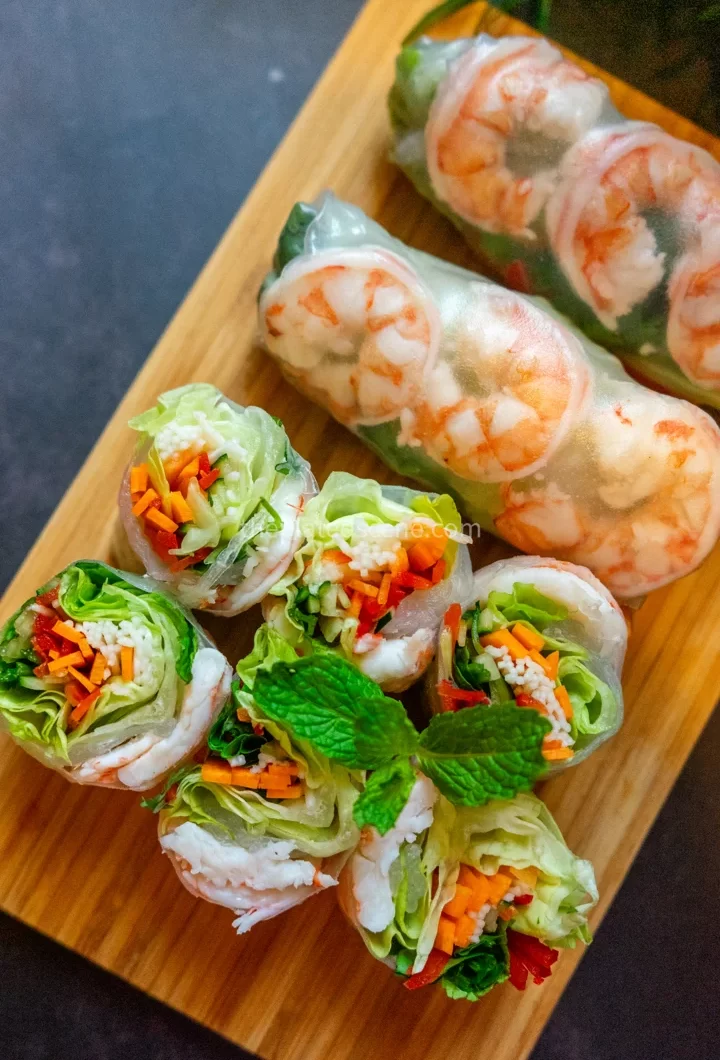I first discovered the Vietnamese fresh spring roll during a phase when I was exploring a vegan lifestyle. Back then, I was on the lookout for meals that were both nourishing and exciting, and these spring rolls fit the bill perfectly. Fresh, light, and satisfying, they became an instant favorite.
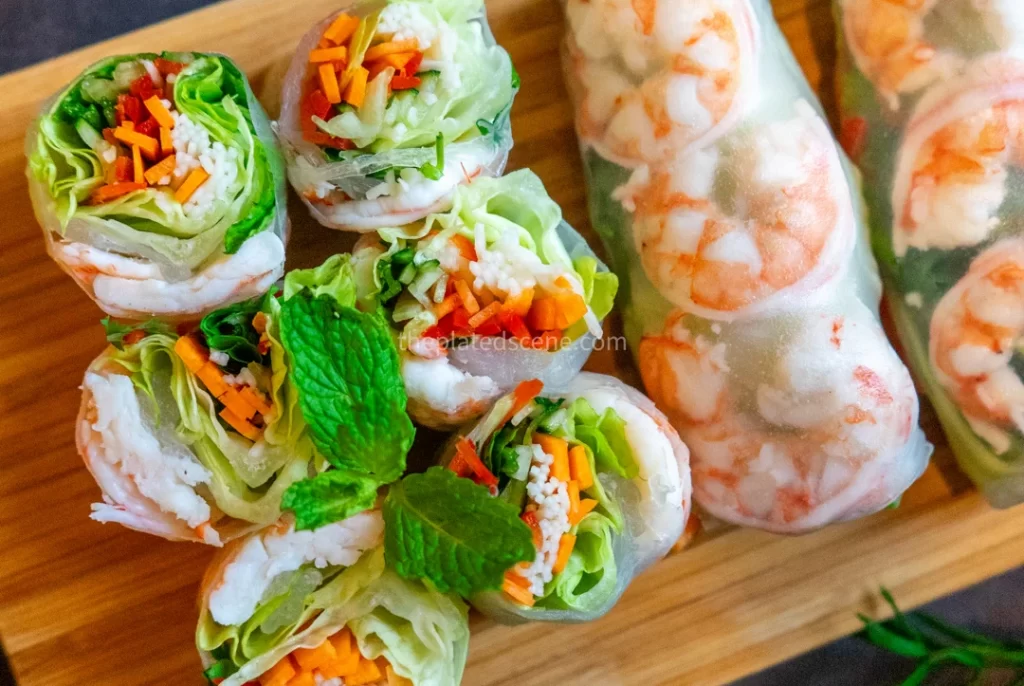
But my appreciation deepened during a trip to Hanoi. I still remember sitting at a quiet roadside stall, watching an elderly vendor expertly roll one after another with such grace and rhythm. Each one was a little parcel of crisp vegetables, soft noodles, and herbs, all wrapped in a delicate sheet of rice paper. The dipping sauce, zesty and savory without being overpowering, tied everything together. That moment was more than just a meal—it was a connection to a beautiful food culture that values balance, freshness, and simplicity.
Table of Contents
The History of Vietnamese Fresh Spring Roll
Known in Vietnam as gỏi cuốn, the Vietnamese fresh spring roll has its roots in the southern regions of the country but has become a beloved dish across Vietnam, including in the north. Unlike the deep-fried variety (chả giò), these fresh rolls are typically served cold, making them a refreshing option, especially during the warmer months.
Traditionally, the rolls were a practical way to enjoy leftovers—small portions of protein, herbs from the garden, and rice vermicelli wrapped in rice paper. Today, they represent far more: a cultural symbol of Vietnamese cuisine that celebrates freshness and balance. And as they’ve traveled beyond Vietnam’s borders, these spring rolls have adapted to countless tastes and dietary preferences around the world.
How the Vietnamese Fresh Spring Roll Tastes
A Vietnamese fresh spring roll is a study in contrast—subtle yet satisfying, delicate but full of character. The first thing you’ll notice is the texture. The rice paper wrap is soft and slightly elastic, almost like silk against your lips, but sturdy enough to hold the vibrant ingredients within. As you bite in, you’re met with a gentle crunch from the lettuce, cucumber, and carrots—clean and cooling, like a reset for your palate.
The vermicelli noodles bring a neutral softness that bridges the vegetables’ freshness with the prawns’ richness. Lightly boiled and sliced, the prawns are tender with a natural sweetness that complements the crisp produce without dominating the flavor. Their mildness makes the herbs, especially mint and Thai basil, shine. These herbs don’t just sit in the background; they burst forward, adding layers of aroma and sharpness that linger on your tongue.
But the true magic happens when you dip the roll into the sauce. My version is a creamy blend of peanut butter, lime juice, sugar, soy sauce, and water—no hoisin, no fish sauce, just clean, balanced flavor. The nuttiness of the peanut butter adds a richness that plays perfectly against the freshness of the roll. The lime juice brings brightness and acidity, while the sugar balances out the tang. Soy sauce adds umami depth, and a splash of water ties everything together into a silky, scoopable dip.
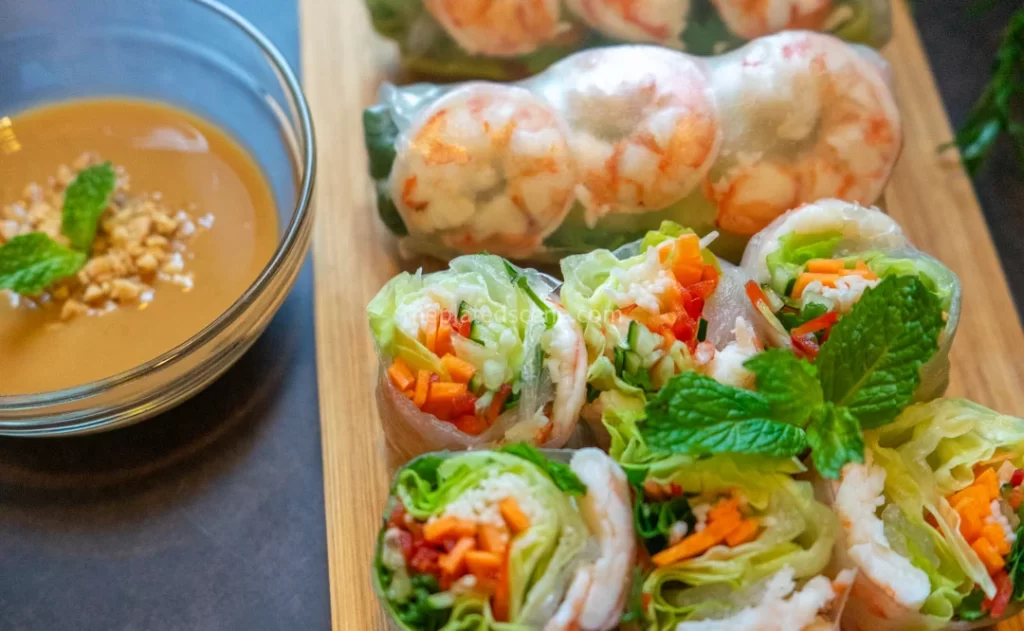
The overall experience of eating a Vietnamese fresh spring roll is light and refreshing, but also deeply satisfying. It doesn’t hit you with overwhelming flavor—it invites you to appreciate the layering of fresh, clean tastes. It’s the kind of food that leaves you feeling nourished, energized, and somehow closer to the earth. Perfect on a hot day, for a light lunch, or as a show-stealing appetizer that always leaves people asking for more.
Variations of Vietnamese Fresh Spring Roll
One of the most delightful things about the Vietnamese fresh spring roll is how flexible and adaptable it is. While the traditional version typically includes prawns, vermicelli noodles, fresh herbs, and lettuce, the variations are endless, and many of them are just as beloved as the original.
For example, tofu and tempeh are popular choices in vegan versions, often marinated and pan-fried for extra flavor. Grilled pork (thịt nướng), shredded chicken, or even slices of hard-boiled egg are commonly used in different regions of Vietnam. Some recipes swap in pickled vegetables for added tang, or wrap in perilla leaves and chives for more complexity and color.
But one twist I love—especially in warmer months—is adding fresh fruit to the rolls. It might sound unconventional at first, but fruit works beautifully in Vietnamese fresh spring rolls because it enhances the refreshing nature of the dish and adds a surprising layer of texture and taste.
- Mango is one of the most popular fruits used. Its natural sweetness and soft, silky flesh complement savory fillings like prawns or tofu and pair especially well with peanut-based sauces. Thin slices of ripe mango bring a tropical, juicy burst that makes each bite more vibrant.
- Avocado, while technically a fruit, adds a creamy richness that balances out the crunch of raw vegetables. It’s a great choice if you want to make the roll feel a bit more filling or indulgent without compromising its lightness.
- Strawberries or green apple slices can be used in more playful, fusion-style rolls—adding tartness, crunch, or sweetness depending on the type. They pair surprisingly well with herbs like mint or Thai basil and work especially well in rolls designed for dipping in lime or soy-based sauces.
- Pineapple can also be used sparingly for a sweet-sour contrast, especially if you’re including grilled meats or tofu in the filling.
Using fruit in Vietnamese fresh spring rolls isn’t just a novelty—it’s a clever way to introduce seasonal or local ingredients, experiment with new flavor combinations, and even turn the roll into a lighter dessert-style dish. Whether you’re hosting a summer gathering or just want something a little different, fruit-filled rolls are a colorful, tasty twist on the classic.
How to Cook the Prawn Filling
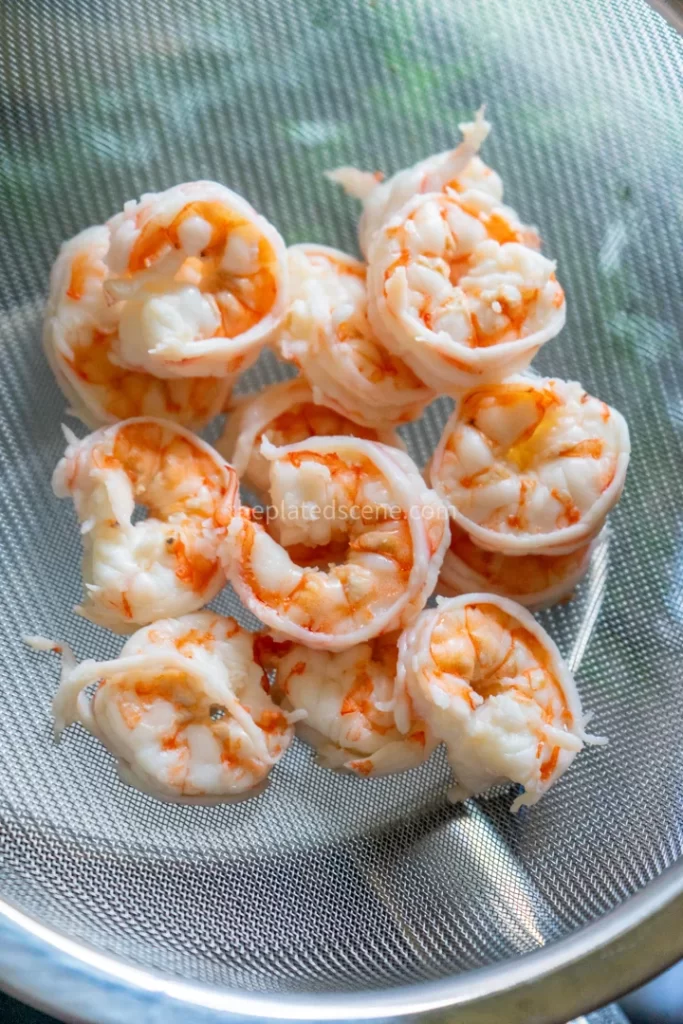

To keep things light, I use boiled prawns as the protein in this Vietnamese fresh spring roll recipe. The process is simple: bring a small pot of water to a gentle boil with a pinch of salt. Add the peeled and deveined prawns, and let them cook for 2 to 3 minutes—just until they turn pink and opaque.
I skip the ice bath step because I find that a quick rest on a dry plate is enough to stop the cooking. Once slightly cooled, I slice the prawns in half lengthwise. This not only gives you that signature look when wrapped in rice paper but also ensures a tender bite that’s easy to layer with other ingredients.
What is Rice Paper and How to Use It
Rice paper, or bánh tráng, is the translucent wrapper that holds everything together in a Vietnamese fresh spring roll. It’s made from a mixture of rice flour and water—sometimes with added tapioca starch for flexibility—and traditionally steamed into thin sheets and dried under the sun. If you’re curious about the traditional process, you can read this guide on how bánh tráng is made for an inside look into its handmade origins.
To use rice paper, fill a large shallow dish or plate with warm water. Dip a sheet for 2–3 seconds—just enough to soften the surface. It will continue to hydrate as you add your fillings. Too much water and it becomes fragile and sticky; too little and it might crack. Once softened, lay it flat on a clean surface and begin layering your ingredients. With a little practice, wrapping becomes second nature.

Using the right brand of rice paper makes a difference too—some are sturdier, while others are more delicate. I recommend trying a few until you find the one that suits your rolling style best.
Why Use Vermicelli Noodles in Vietnamese Fresh Spring Rolls
A key component of the Vietnamese fresh spring roll is the inclusion of rice vermicelli noodles—those thin, soft strands that nestle perfectly alongside herbs, vegetables, and protein. They may seem subtle in flavor, but their presence plays an important role in the structure and mouthfeel of the roll.
So, why vermicelli and not other types of noodles?
First, texture. Vermicelli noodles are soft and slightly chewy, offering a pleasant contrast to the crispness of raw vegetables and the tenderness of prawns or tofu. They’re not slippery like glass noodles or heavy like egg noodles, which makes the rolls easier to grip, bite into, and enjoy without everything falling apart.
Second, absorption. Vermicelli noodles are made from rice flour and have a mild, neutral taste that absorbs flavors from the dipping sauce and other fillings without competing with them. They act as a subtle canvas, allowing the herbs, vegetables, and protein to shine while still adding body and substance to each bite.
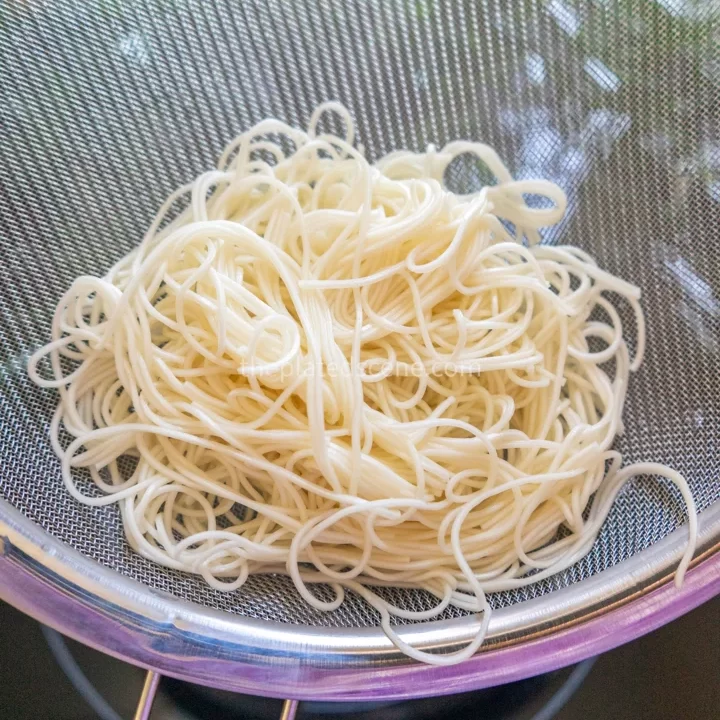
Third, tradition and balance. In Vietnamese cuisine, balance is everything—lightness, freshness, and harmony. Vermicelli noodles strike that balance perfectly. They’re light enough to keep the roll feeling fresh, but substantial enough to make it satisfying as a snack or light meal. Other noodle types like ramen, soba, or udon would be too thick, too bold in flavor, or too clunky in texture to complement the delicate wrapping and raw fillings.
Lastly, practicality. Vermicelli noodles cook quickly, are easy to portion, and hold their shape well once cooled. This makes them a reliable choice for rolling and meal prep, especially when serving a crowd.
In short, vermicelli noodles are the quiet backbone of the Vietnamese fresh spring roll—not flashy, but absolutely essential for achieving that signature lightness and satisfying bite that makes the dish so beloved.
Vegetables and Herbs for Vietnamese Fresh Spring Rolls (And How to Prepare Them)
One of the joys of making Vietnamese fresh spring rolls is the vibrant mix of vegetables and herbs tucked into each one. They add crunch, freshness, color, and fragrance—making every bite feel alive and clean. Here’s the lineup I use in my version, along with simple prep tips to get the best texture and rollability:
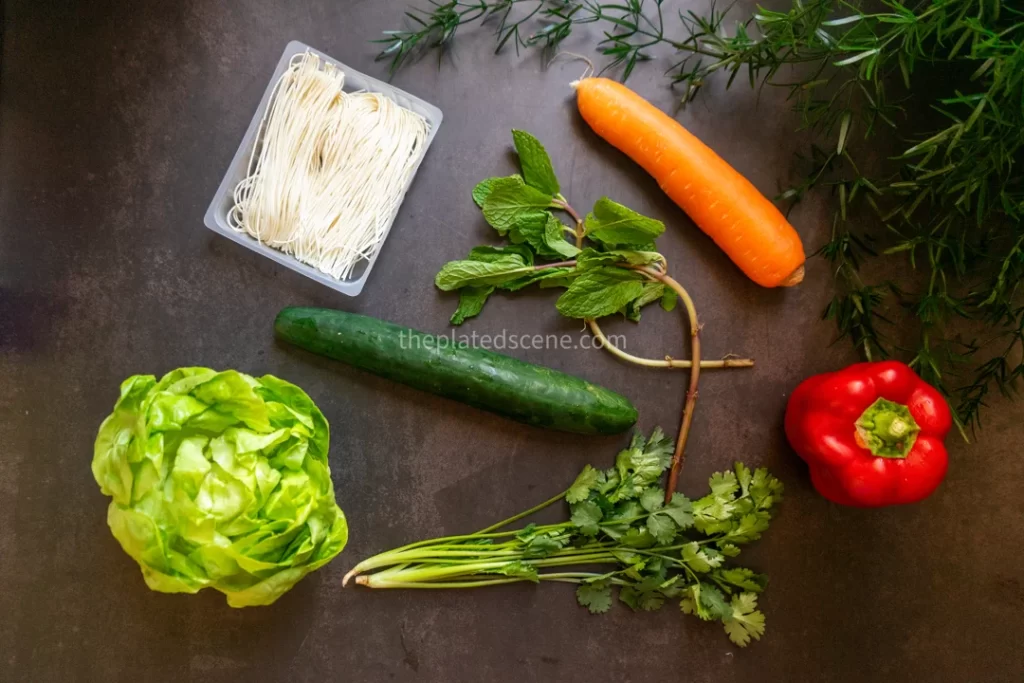
1. Carrot
- Why: Offers natural sweetness, crunch, and color contrast.
- How to prepare: Peel and julienne using a mandoline or sharp knife. The pieces should be thin enough to fold easily into the roll. Optional: blanch for 10–15 seconds if you prefer a softer texture, but I usually keep them raw.
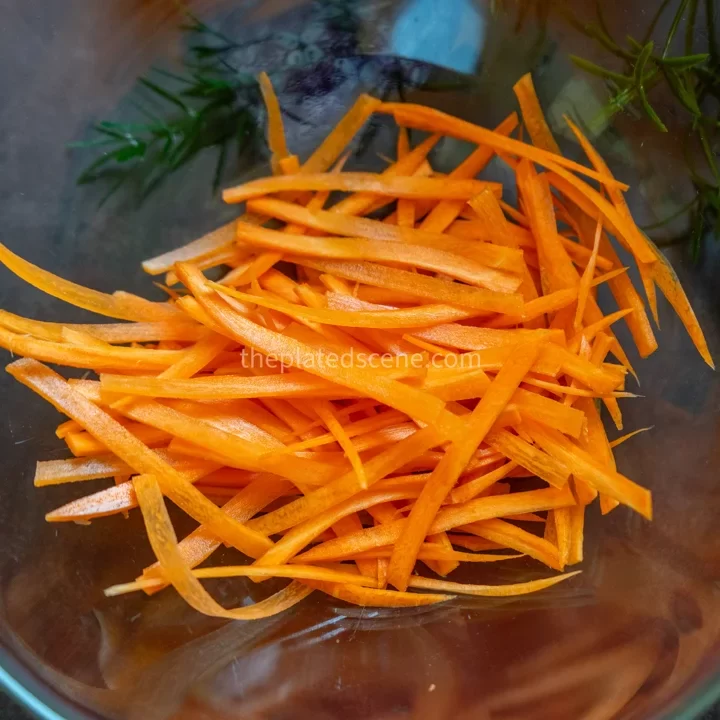
2. Capsicum (Bell Pepper – any color)
- Why: Brings a sweet, juicy crunch and brightens the overall look of the roll.
- How to prepare: Remove the seeds and core, then slice into thin strips. Red, yellow, or orange capsicum work beautifully here for color variety.
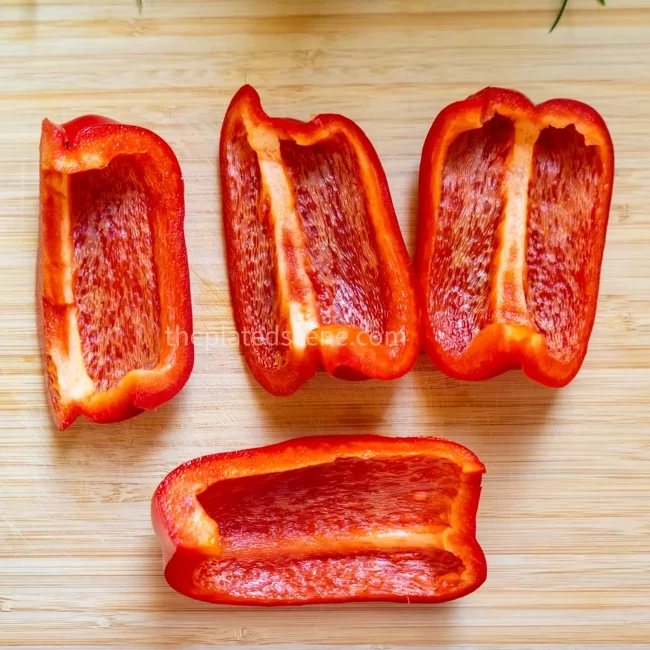

3. Lettuce (Butterhead)
- Why: Provides softness, moisture, and a gentle wrap for the inner fillings. Butterhead lettuce is especially great because of its tender leaves.
- How to prepare: Separate the leaves, trim the thickest parts of the stem if needed, and gently pat dry after washing. You can either leave the leaves whole or tear them into smaller pieces to fit your roll size.
4. Cucumber (Kyuri – Japanese cucumber)
- Why: Cool and crisp, kyuri cucumbers are less watery and have thinner skin, making them perfect for rolling.
- How to prepare: Wash well, then slice lengthwise into thin matchsticks. I don’t peel them, but you can if you prefer a more delicate texture.


5. Mint Leaves
- Why: Adds a clean, cool note that brightens every bite. Mint is essential to that signature fresh spring roll flavor.
- How to prepare: Pick whole leaves from the stem and give them a quick rinse. Pat dry gently with a towel to avoid sogginess.
6. Cilantro (Coriander Leaves)
- Why: Brings a fragrant, citrusy lift that works beautifully with lime-based dipping sauces and prawns.
- How to prepare: Trim the thicker stems and use mostly the leafy tops. You can leave small sprigs whole or give them a light chop if you prefer a more even distribution in the roll.
Tip: Prep all your vegetables and herbs ahead of time and keep them arranged in separate piles or small bowls. This not only makes the rolling process smoother but also lets you customize each roll to your taste.
How to Fold Vietnamese Fresh Spring Rolls
Folding a Vietnamese fresh spring roll might seem tricky at first, but once you get the hang of it, it becomes a soothing and almost meditative process. The key is to work gently but with confidence—and to make sure your fillings are neatly layered before you begin.
Here’s a simple step-by-step guide to help you fold your rolls perfectly every time:
1. Soften the rice paper
Fill a shallow dish or large plate with warm water. Dip one sheet of rice paper into the water for just 2–3 seconds. It will still feel slightly firm when you take it out, but it will continue to soften as you work. Lay the softened rice paper flat on a clean surface, such as a damp cutting board or a plate.

2. Layer the ingredients
Start by placing a small handful of lettuce near the bottom third of the rice paper (about 2 inches from the edge). On top of that, layer your vermicelli noodles, sliced vegetables (I use a mandoline to keep them thin and uniform), and herbs. If using prawns, lay the halved pieces in a single line just above the main stack of fillings—this way, they’ll be visible through the rice paper when rolled.
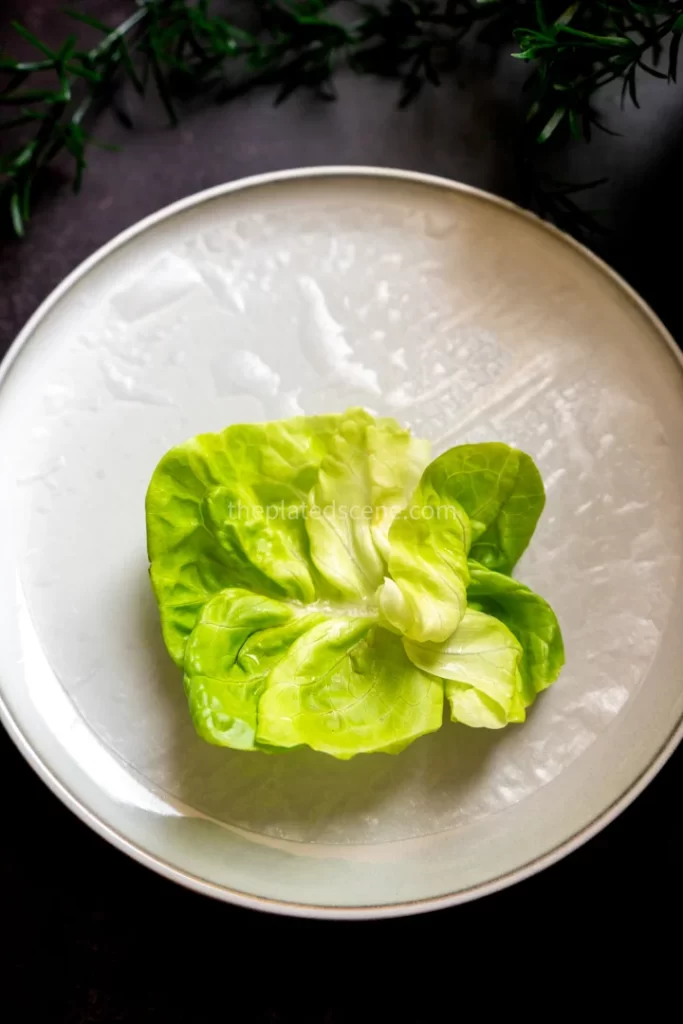
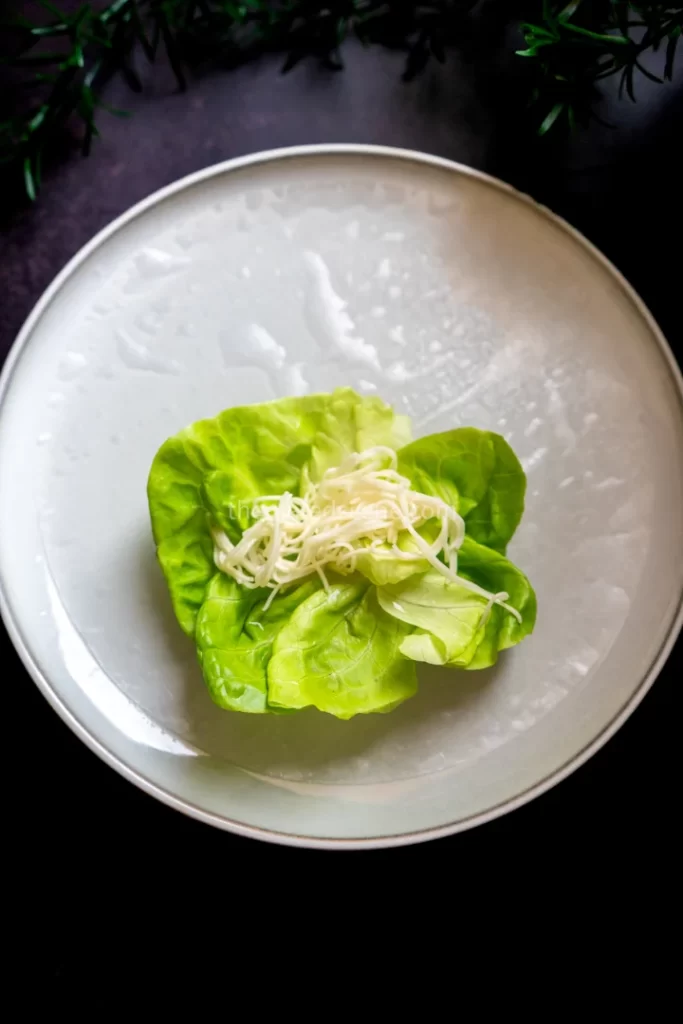
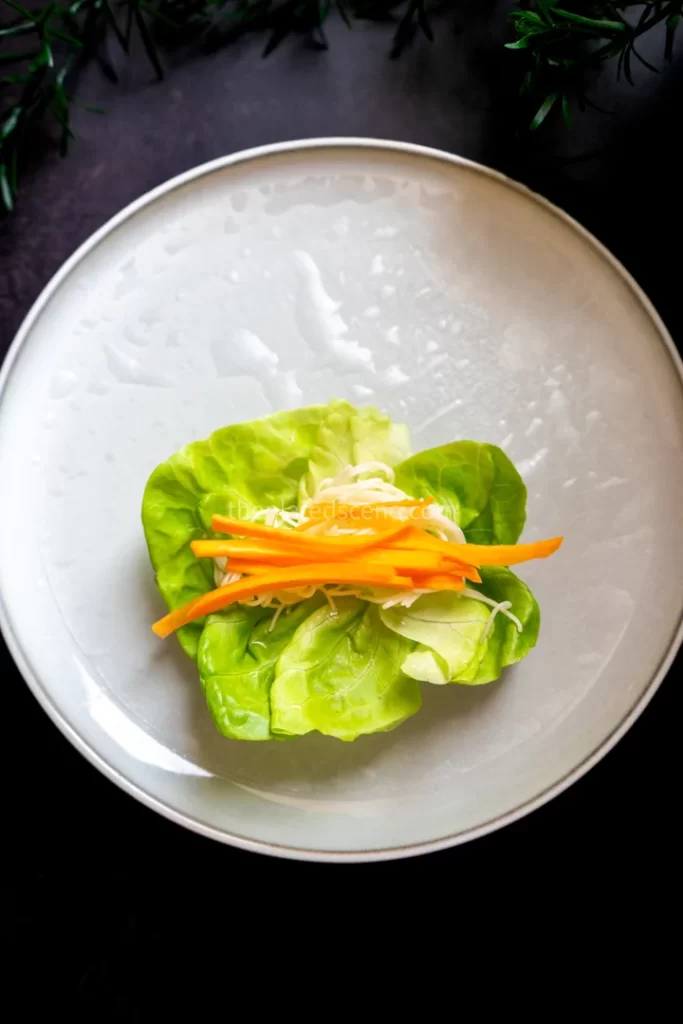
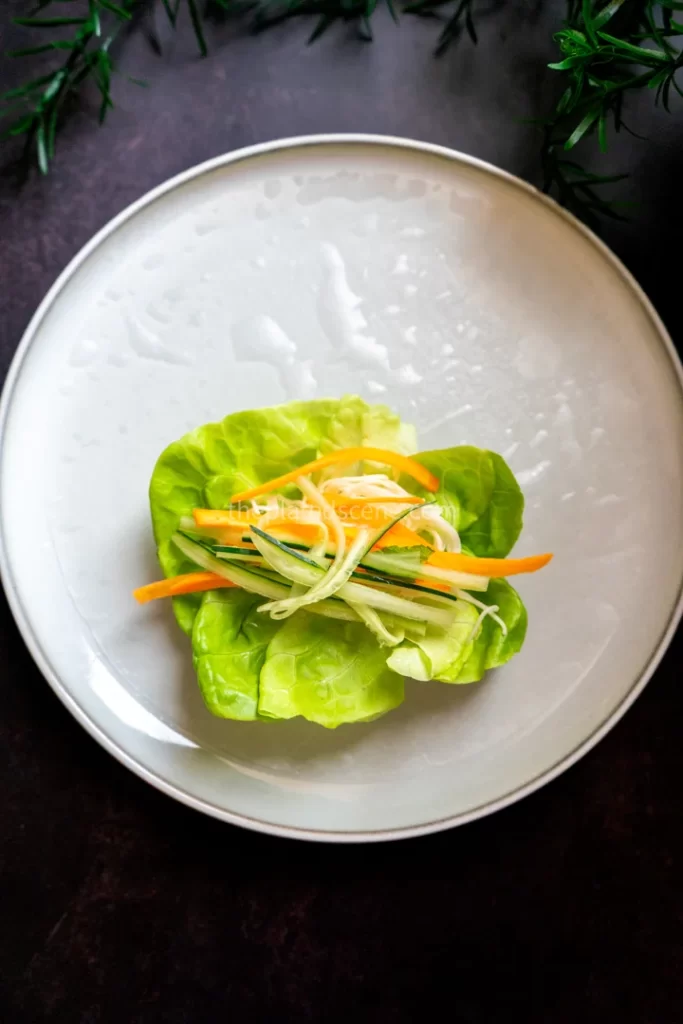
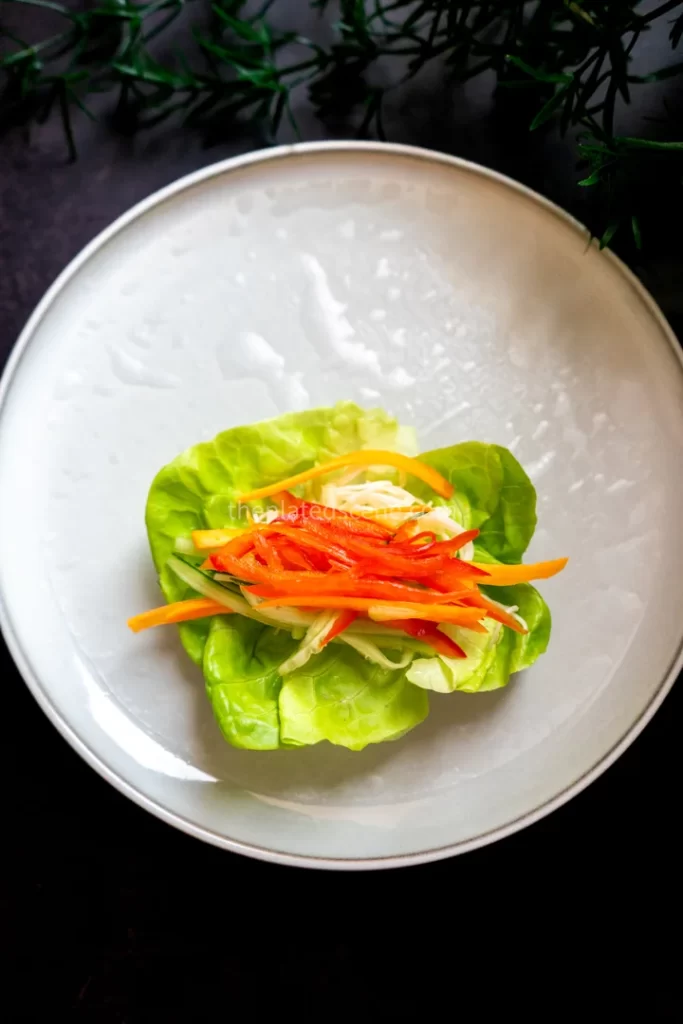
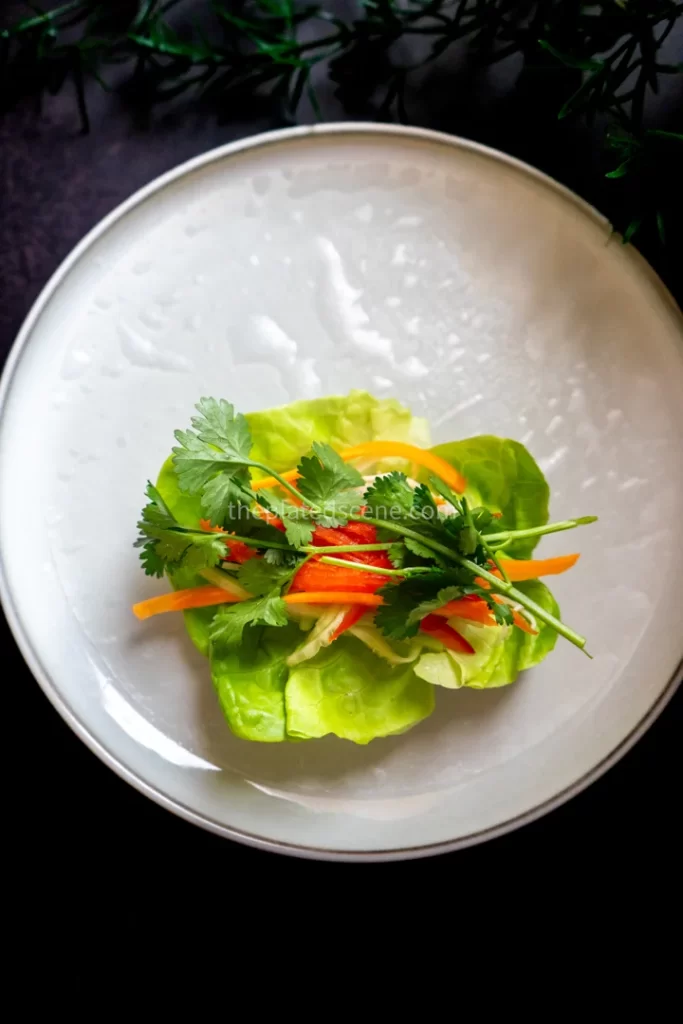
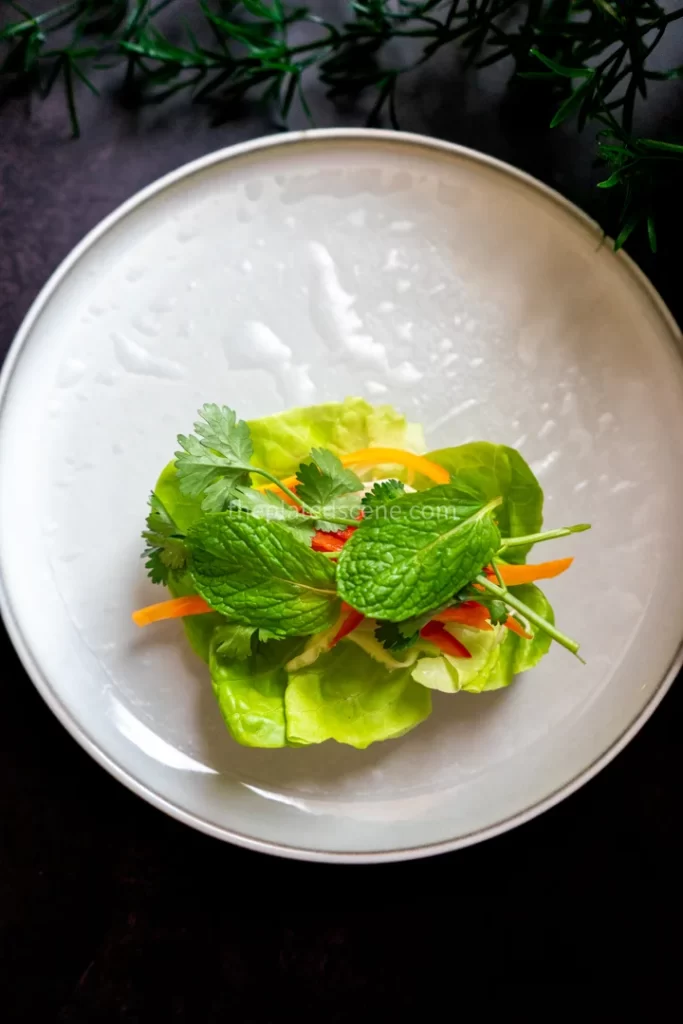

3. Fold the bottom up
Gently lift the bottom edge of the rice paper and fold it over the filling. Use your fingers to tuck the filling in tightly as you roll.

4. Fold in the sides
Next, fold in the left and right sides of the rice paper like you’re wrapping a burrito. This helps seal the edges and keeps everything contained.
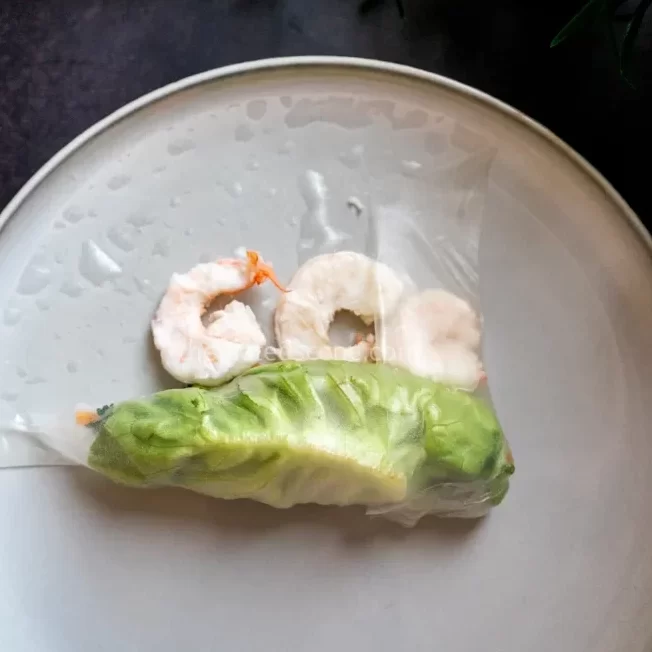
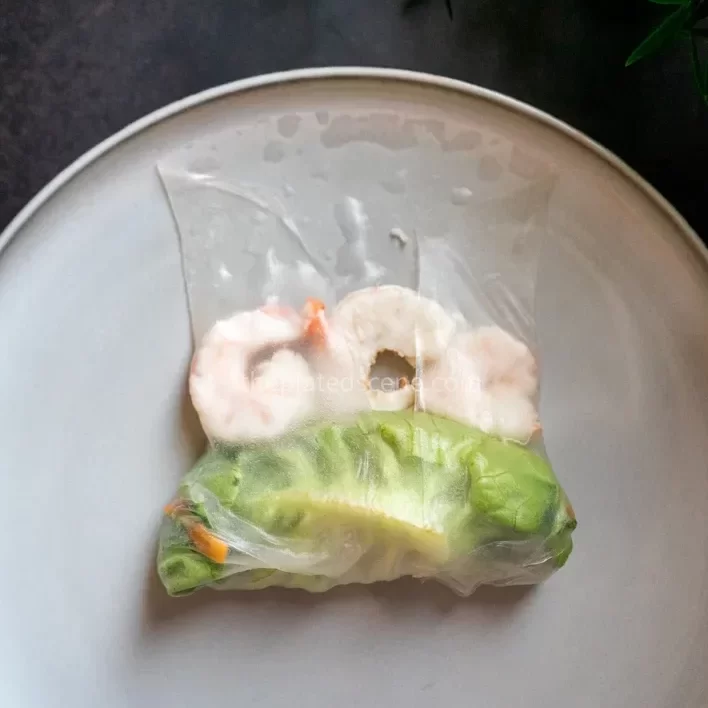
5. Roll it up
Continue rolling upward, gently but firmly, until the entire sheet is rolled and sealed. The rice paper will stick to itself and hold everything together without needing any glue or closure.
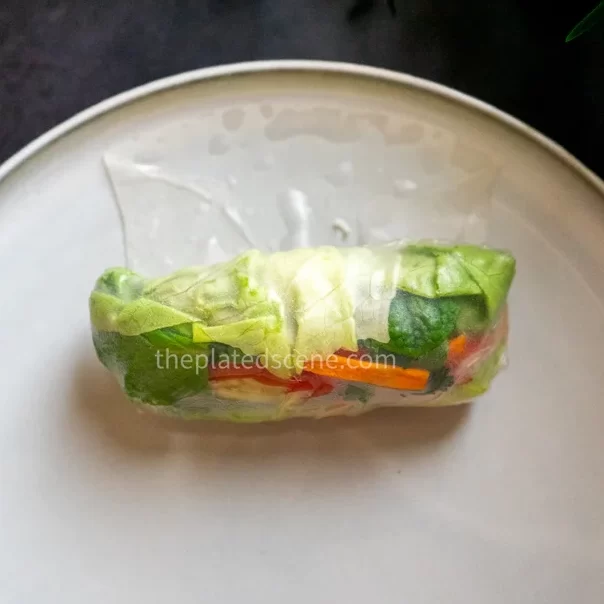
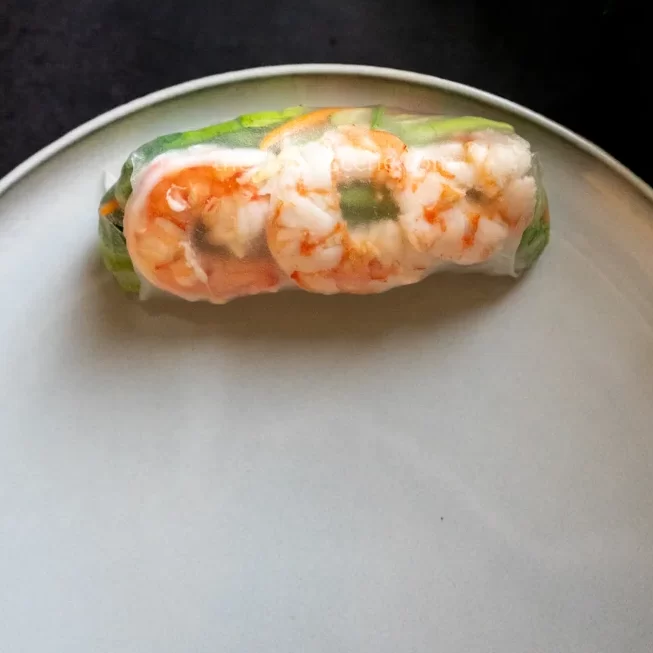
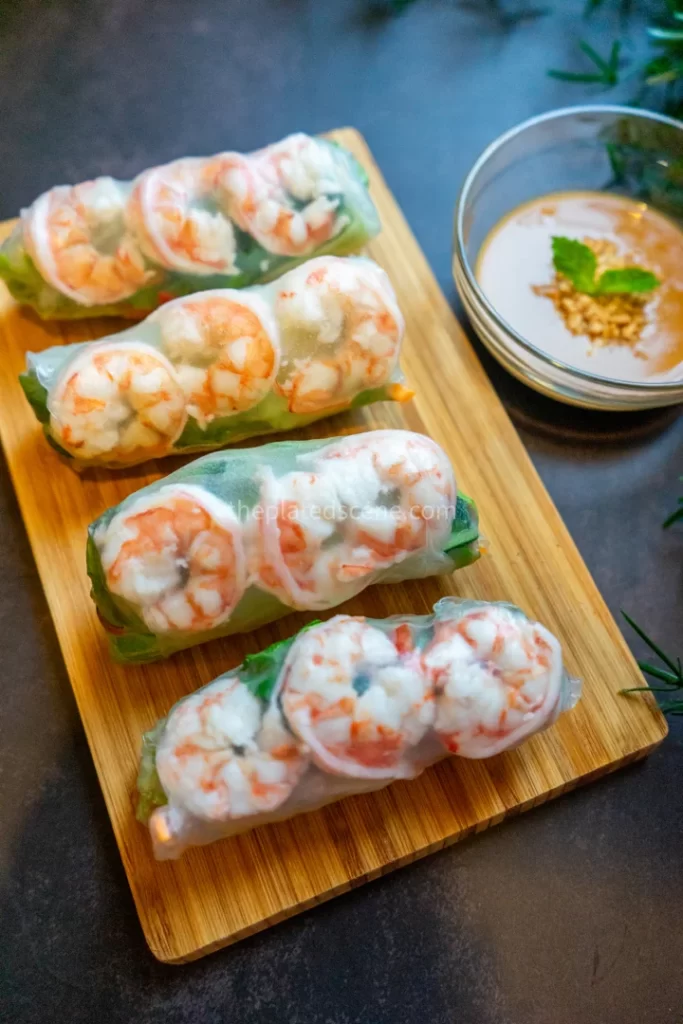
Tips for success:
- Keep your hands slightly damp to prevent sticking.
- Don’t overfill the roll—less is more when you’re just starting out.
- If your rice paper tears, don’t worry. You can either patch it with a second sheet or just eat that one as your “tester” roll.
With a bit of practice, you’ll be folding Vietnamese fresh spring rolls like a pro—uniform, tight, and beautiful every time.
Why I Omit Fish Sauce in This Recipe
Fish sauce is a staple in many Vietnamese dishes, known for its deep umami and salty complexity. It’s commonly used in traditional dipping sauces for Vietnamese fresh spring rolls, often blended with lime juice, sugar, garlic, and chili to create a balanced, savory dip.
But in this recipe, I intentionally leave it out. There are a few reasons for that. First, I wanted to create a version of Vietnamese fresh spring rolls that’s more inclusive—one that works for people who follow a vegetarian or vegan diet, or who simply prefer to avoid fermented fish products. Fish sauce can also be quite pungent, which some people find overwhelming, especially in a dish that highlights fresh, delicate ingredients.
Instead, my dipping sauce leans into a creamier, nutty profile. It’s made from peanut butter, lime juice, sugar, soy sauce, and water—a simple mix that still delivers bold flavor and a silky texture. The peanut butter brings richness, the lime juice adds a citrusy brightness, and the soy sauce steps in to provide a gentler, plant-based umami. It’s a flavorful, well-balanced sauce that complements the fresh ingredients without relying on fish sauce or hoisin.
This tweak keeps the dish light and clean, but still deeply satisfying—proving that you can stay true to the spirit of Vietnamese fresh spring rolls while making the recipe your own.
Things to Watch Out For
Even though Vietnamese fresh spring rolls are relatively easy to assemble, there are a few things that can trip you up the first time around:
- Overfilling: This is one of the most common pitfalls. Too many fillings can make the rice paper tear or the roll burst open.
- Rice paper soaking: Don’t let the rice paper soak too long. It will continue softening once laid out, so keep the dip quick.
- Timing: Serve the rolls fresh. If they sit too long, the rice paper can get soggy and sticky.
- Moisture control: After washing your veggies and herbs, pat them dry. Too much moisture can make wrapping tricky.
- Uniform slicing: I use a mandoline to thinly slice the vegetables, ensuring even layers and an easy-to-roll shape. This makes the finished rolls not only neater but more pleasant to bite into.
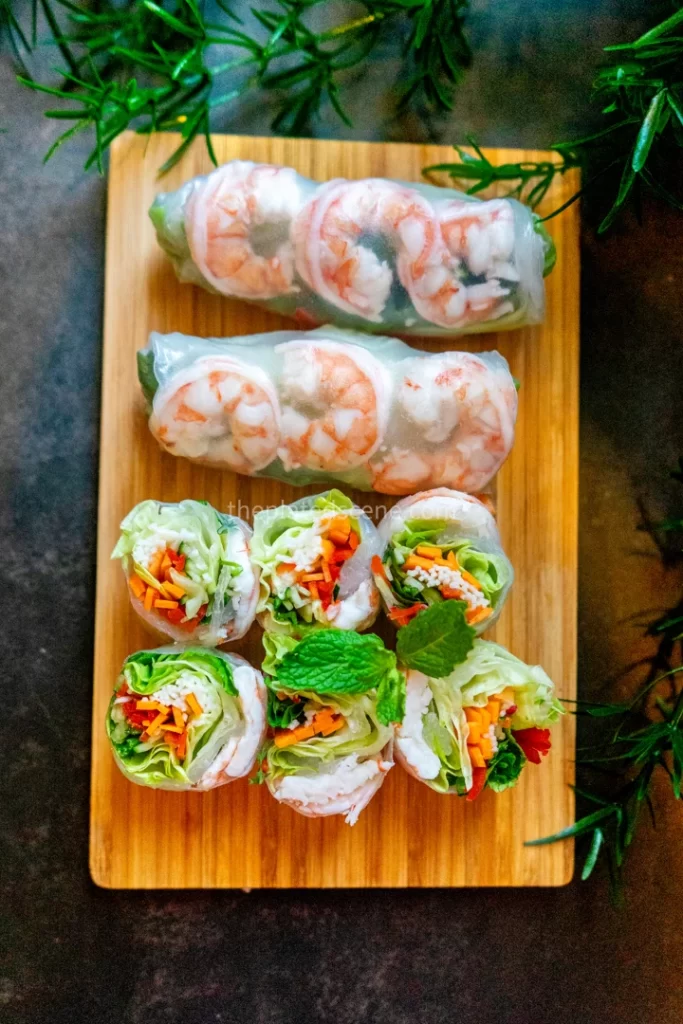
Nutrition Guide for Vietnamese Fresh Spring Rolls
Vietnamese fresh spring rolls are not just refreshing and delicious—they’re also a great choice for a balanced, nutrient-dense meal. Here’s a breakdown of the key macronutrients and micronutrients found in a single roll (including a small serving of dipping sauce).
Estimated Nutrition per Roll (with Prawns and Peanut Sauce):
- Calories: ~120–150 kcal
- Protein: 6–8g
- Carbohydrates: 15–18g
- Fat: 4–6g
- Fiber: 1.5–2.5g
- Sugar: ~3–5g
- Sodium: ~200–300mg (varies depending on soy sauce)
Macronutrient Breakdown
- Protein
Each roll provides a moderate amount of protein from prawns (or tofu in vegan versions) and peanut butter. Prawns are a lean source of protein, low in fat and calories, while peanut butter adds both protein and healthy fats. - Carbohydrates
The rice vermicelli and rice paper contribute most of the carbs. These are generally easy to digest and make the rolls satisfying without being heavy. Adding more vegetables increases fiber without raising calories. - Fats
Most of the fat comes from the peanut butter in the dipping sauce. It’s primarily unsaturated fat, which supports heart health. You can reduce fat by using a lighter sauce or less peanut butter, or increase it by using more sauce or adding avocado to the roll.
Micronutrient Highlights
- Vitamin A
Thanks to the carrot, mint, and cilantro, these rolls are rich in beta-carotene (Vitamin A), which supports eye health and immunity. - Vitamin C
Capsicum, mint, and lime juice in the sauce all provide a good amount of Vitamin C—important for skin, immune function, and iron absorption. - Vitamin K
Butterhead lettuce and fresh herbs are excellent sources of Vitamin K, which supports healthy blood clotting and bone health. - Folate
Leafy greens and fresh herbs contribute folate, a B-vitamin important for cell function and especially essential during pregnancy. - Iron
Prawns contain a modest amount of heme iron, while leafy greens and herbs provide non-heme iron. The lime juice in your dipping sauce helps improve absorption. - Calcium & Magnesium
Peanut butter offers a small but notable dose of calcium and magnesium, both essential for bone health and muscle function. - Potassium
Cucumber, mint, and capsicum contain potassium, which supports heart and muscle function and helps regulate blood pressure.
Allergy and Dietary Notes
- Gluten-free: If using gluten-free soy sauce or tamari.
- Dairy-free: Naturally.
- Nut-free: Substitute sunflower seed butter for peanut butter in the sauce.
- Low-calorie and low-fat option: Skip the sauce or use a light vinegar-based dip instead.
How to Store Vietnamese Fresh Spring Rolls
Vietnamese fresh spring rolls are best enjoyed immediately after assembling, while the rice paper is still soft and the vegetables are crisp. However, if you need to make them in advance or store leftovers, here are some tips to help keep them fresh:
Short-Term Storage (Same Day)
- Wrap each roll individually in damp paper towels to prevent sticking and drying out.
- Place the wrapped rolls in an airtight container.
- Store in the refrigerator for up to 4–6 hours.
- Before serving, let them sit at room temperature for about 15–20 minutes to soften the rice paper slightly. Do not microwave.
Next-Day Storage
- You can still store them overnight, but note that the rice paper may become a little dry or tough, and the vegetables might release moisture.
- If storing overnight, line the container with a damp towel, then wrap each roll in plastic wrap or keep layers separated with parchment paper to prevent sticking.
- Re-moisten slightly with a damp paper towel if the rice paper feels too dry before serving.
Storing the Ingredients Separately
If you’re meal-prepping or planning to serve rolls later:
- Store the prepared vegetables, cooked prawns, and vermicelli noodles separately in airtight containers in the fridge.
- Assemble just before eating for the best texture and appearance.
You Might Also Like
If you’re drawn to the freshness and simplicity of Vietnamese fresh spring rolls, here are a few more refreshing dishes from The Plated Scene that you might enjoy:
- Urap Sayur (Indonesian Steamed Vegetable Salad with Coconut Dressing)
A cooling and herbaceous vegetable dish tossed in sweet-spicy grated coconut. It’s light, aromatic, and makes a perfect side to any summer meal. - Kering Tempe (Crispy Sweet-Savory Tempeh). Though crispy, this dish is served at room temperature and adds a lovely texture contrast to fresh meals. The tempeh is coated in a glossy, lightly sweet glaze with just a touch of chili.
- Ketoprak (Jakarta-style Tofu Salad with Peanut Sauce). Silken tofu, rice cake, and vermicelli noodles come together with bean sprouts and crunchy crackers, all drizzled in a garlicky peanut dressing. Served at room temp—it’s hearty yet incredibly fresh.


